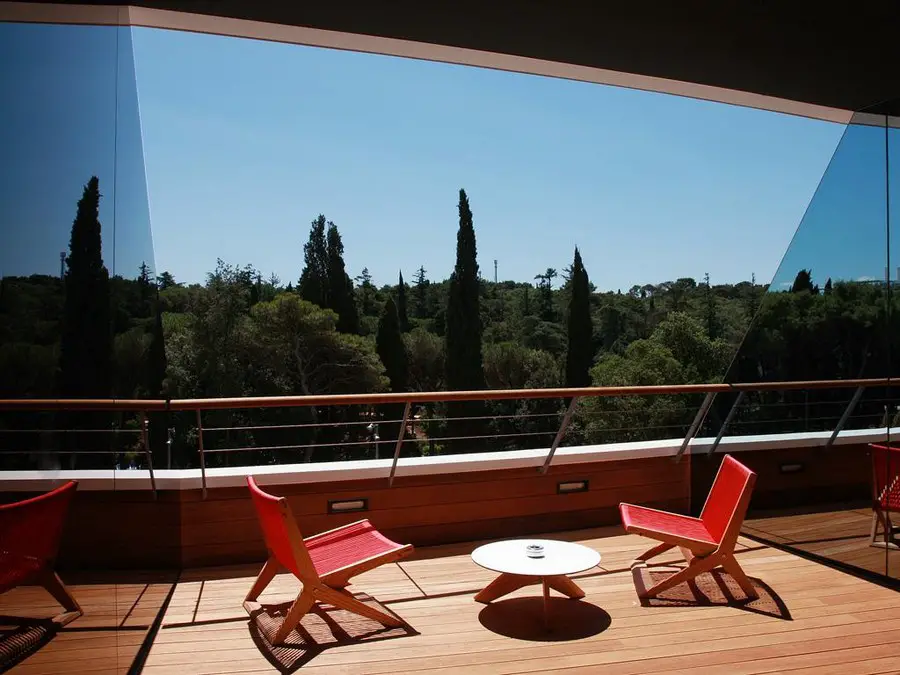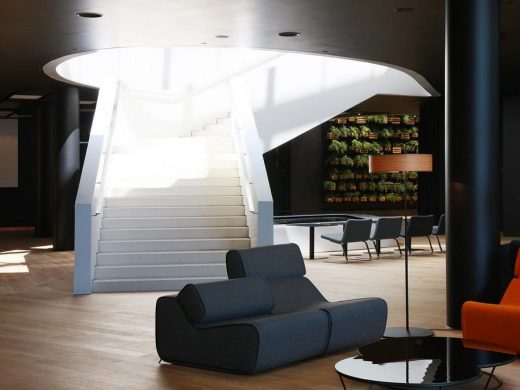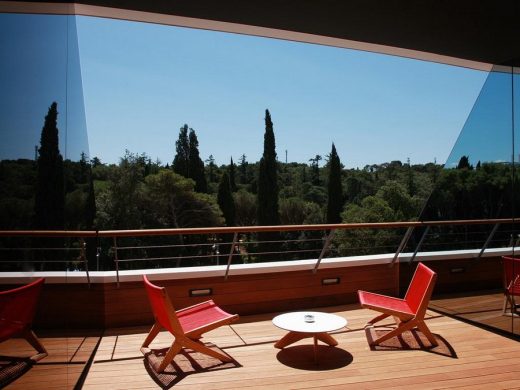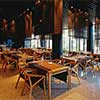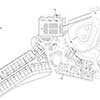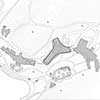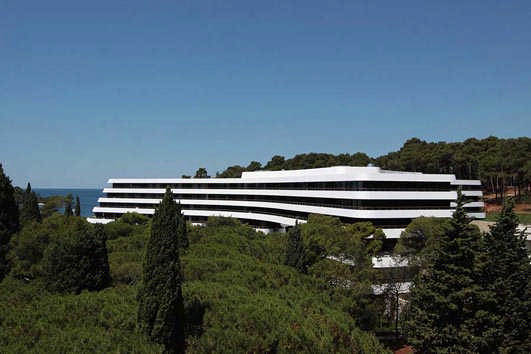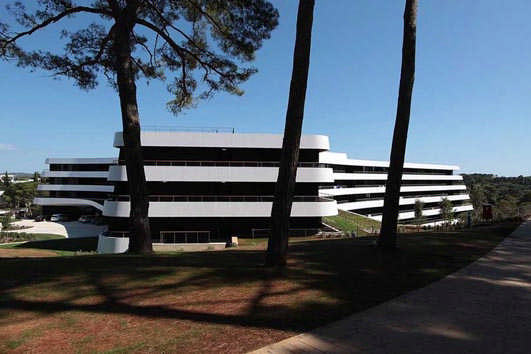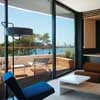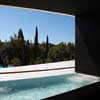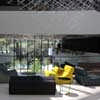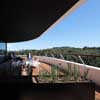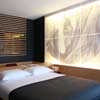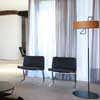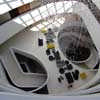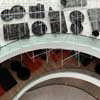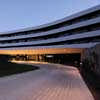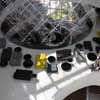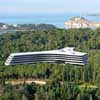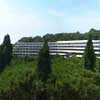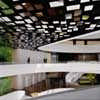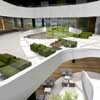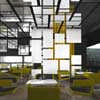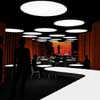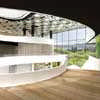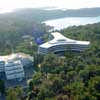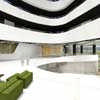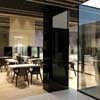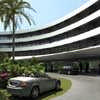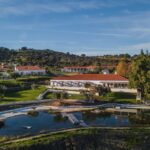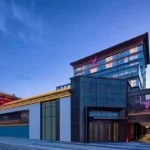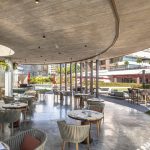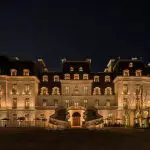Hotel Lone Rovinj Building, Croatian Architecture, Istria Project Images, Location
Hotel Lone, Istria, Croatia : Rovinj Architecture
Monte Mulini Building, Istria design by 3LHD Architects, Croatia, Europe
3 Apr 2013
Hotel Lone in Istria
Design: 3LHD architects, Zagreb
Hotel Lone, the first design hotel in Croatia, is situated in a unique and protected region of Monte Mulini forest in Rovinj. It was created by a team of architects, artists, product, fashion and graphic designers. The hotel’s identity is defined by façades dominant horizontal lines – terraces evoking the image of slanted boat decks.
The interiors and the furniture were designed for the hotel in order to achieve a recognizable identity. The Y shaped ground plan enabled a rational and functional organizational scheme; quality views from all rooms and the grouping of public facilities around a vertical lobby that connects common spaces on all levels, creating a central volume of impressive height. Surrounding landscape is the hotel’s signature visual element which also defines all views of the interior.
The ambient light and Mediterranean greenery reflects on the glossy surfaces in public areas and on the mirrored panels in the rooms, pulling them deeply into the interior and intensifying the effect of the surrounding plants. The conceptual assumptions used in the design of the hotel and its interior show evidence of a deep respect towards the achievements of modernist hotel architecture on the Adriatic Coast from the previous century, combining it with a strong conteporarity expressed in materials, functions, typologies and in architectural forms.
The buildings compact form gives it a favorable form factor and a minimal loss of heat through the surface area. Energy use for cooling is minimized with reduced solar heat gains through the main elements of the facade – deep eaves formed by continuous parapet balconies. Optimal air-conditioning was achieved by implementing air to air heat pumps with low noise units, small required installation space and, thanks to high energy efficiency of inverter driven compressors, minimizing running costs and CO2 emission.
3 Aug 2011
Hotel Lone, Croatia
Hotel Lone, Rovinj, Istria, Croatia
Date built: 2011
Design: 3LHD architects, Zagreb
Hotel Lone, the first design hotel in Croatia, is situated in the Monte Mulini forest park, Rovinj’s most attractive tourist zone, located in the immediate vicinity of the legendary Eden Hotel and the new Monte Mulini hotel. The surrounding grounds and parkland is a unique and protected region of the Monte Mulini forest on the Lone Bay.
The term design hotel is meant to illustrate this as a space that nurtures the concept of an interesting and functional design. Created by a team of renowned Croatian creatives comprised of a new generation of architects, conceptual artists, product, fashion and graphic designers. The Architects from studio 3LHD were responsible for the design and construction of the hotel building. In addition to the overall architecture, the interiors and the furniture were designed and chosen especially for the hotel in order to achieve a distinct and recognizable identity. The designers from Numen / For Use designed the furniture.
The fashion studio I-GLE designed the staff uniforms and other textiles. Artist Silvio Vujičić created graphics on fabrics for the rooms. Installations in the hotel lobby were made by a group of innovative artists: Ivana Franke – “Room for running ghosts”; Silvio Vujičić – “In the hanging garden no one speaks” and the fashion studio I-GLE – textile compositions No1, No2, No3. Studio92 designed the Wellness & Spa center, while Studio Kappo did Landscape design. The agency Bruketa & Žinić OM conceived and oversaw the visual identity of the hotel.
The hotel’s identity is recognized through the external design of the building, with a facade that is defined by dominant horizontal lines – terrace guards designed to evoke the image of slanted boat decks. The building’s floorplates contract from level to level going up, creating an elevation that is tapered at all angles. The site’s complex terrain with dramatic altitude changes determined the locations of internal facility spaces through a dynamic interweaving of public areas and guest suites at all levels.
The specific Y shaped ground plan enabled a: rational & functional organizational scheme; quality views from all rooms; and the grouping of public facilities around a central vertical lobby. The main lobby connects common spaces on all levels, creating a central volume of impressive height and scale with interesting views in and around where all vital functions of the hotel take place.
When designing the interior, 3LHD and the designers from Numen/For Use chose the surrounding ambiance as the hotel’s signature visual element which also defined all views of the interior. With that in mind, the walls in the rooms are covered with mirrored panels, distributed in a random pattern which reflects ambient light and Mediterranean greenery, pulling them deeply into the interior, filling it with the exterior. The greenery also reflects on the glossy surfaces of ceilings in public areas, intensifying the effect of the surrounding plants.
The visualy light and open space of the lobby is covered in white stone surfaces and beige-golden fabrics, the oval lines of the mezzanine guards and the furniture enhance the fluid character of the space and are in contrast with the intimate, subdued tones of the rooms and suites where the atmosphere is calmer, materials warmer (wood and carpets), the colors darker and lighting dimmer. The entire design of the hotel is based on contrasts (black, white, wood) and fabrics as the unifying element, varying from a fluid thin veil in the restaurant, through functional but dynamic wall coverings in the rooms, to the richly decorative mural in the lobby.
The key to the concept was the awareness of the necessity to avoid the sterility of most hotel facilities; that is why the designers used textiles with rich textures and quality oak veneer treated with eco-friendly lacquers, which give the visual and tactile impression of untreated massive wood. This material is usually too rustic but in this execution it manages to integrate walls and spaces into a harmonious composition through contemporary design and purified, spatially articulated shapes of paneling that overflow into furniture.
The conceptual assumptions used in the design of the hotel and its interior show evidence of a deep respect towards the achievements of hotel architecture on the Adriatic Coast from the previous century, combining it with a strong modernity expressed primarily in materials, functions and typologies and consequently in architectural forms.
Hotel’s facilities
The hotel has 236 rooms and 12 suites. 16 rooms offer an exclusive experience of a private massage pool built in the room’s terrace. All the rooms are suitable for all types of guests. Rooms with king-size beds, twin beds or connected rooms are suitable for families.
The hotel has three restaurants “L”, “ON” and “E”, two bars, a jazz club and a mini club.
One of the main characteristics of the hotel is the state-of-the-art high-quality conference center with 4 conference halls, several meeting rooms, and a VIP lounge fully equipped with the most advanced technology and an accompanying bar.
The hotel’s lowest level has a wellness center inspired by the Mediterranean. Besides a big pool there is a fitness center, massage rooms, a relaxation zone with a vitality bar, saunas and hydro massage pools – so called “sunken rooms”.
Furniture design
Numen/For use, Nikola Radeljković, Sven Jonke, Christoph Katzler
The common denominator, exquisitely designed furniture, connects all the hotel’s areas. Most of the furniture are carefully selected manufactured pieces, but also includes items made especially for this hotel by the well known design group Numen/For Use.
To achieve immediate recognizability of the interior, the Numen/ForUse group chose probably their most famous furniture piece, the Satyr armchair (Wallpaper award for Best World Sofa 2007), as an object with character and strong identity. The Satyr is present in all rooms with different colors of textile depending on the room’s position. Another signature piece found in all rooms is the lamp made by Dekor from Zabok and designed especially for the Hotel Lone. The lamps also differ in materials used for lampshades depending on the position in the room. During the day they “drown” in their background and dematerialize their volume, while at night, when turned on, they enhance the comfortable and warm atmosphere of the room.
Most of the furniture in the public spaces is also designed by Numen/For Use, the series of seating elements Transform, Y chair and C chair produced by the famous Italian furniture company Moroso. Some of the furniture is made from massive oak, tables XYZ and models X-L and X-Z are from the Element program made by Intera, Zagreb. Intera also made the specialized foldable armchairs for terraces and chaises with integrated parasols. These products were made especially for the Hotel Lone and in the future will be available to the public. In this way the development of this hotel becomes more than just another tourist project – it represents a driving force for the development of domestic production of designer furniture, which should serve as a role-model to all investors in Croatian tourism.
To avoid the classic ideal of Gesamtkunstwerk, the furniture in Hotel Lone is not bound to only one designer name or collection but rather consists of a variation of designer pieces. For example, the Tio collection by the design duo Chris Martin and Magnus Elebäck from Massproduction; Tropicalia chair by Patricia Urquiola for Moroso, the 1966 collection by Richard Schultz for B&B Italia; and an especially interesting piece we would like to single out is the conference chair GF 40/4 by David Rowland for Howe, which was designed more than 40 years ago and still represents a timeless model for a conference chair.
Staff uniforms and selection of textile objects design
I-GLE, Nataša Mihaljčišin, Martina Vrdoljak Ranilović
A cult favourite of the Croatian fashion scene, designer duo I-GLE use their distinctive approach and style when designing all the textiles at Hotel Lone. A special project was to design hotel staff uniforms. Modern and simple, made of high quality and comfortable fabrics with an emphasis on the personality of people who represent certain positions in the context of a hotel, employee uniforms provide a pleasing visual identity that fits well into the hotel’s overall image. I-GLE participated in designing and choosing the fabrics for all textile items: curtains and drapes, tablecloths, napkins, sheets…
Spatial installation Room for running ghosts Ivana Franke, artist
Materials: Aluminum tubes, PFA monofilament (fishing line), steel wire.
Dimensions: Diameter 8.7 m
In her work, internationally renowned visual artist Ivana Franke explores the relationship between phenomena and materiality by questioning the experience of spatial dimensions and human perception. Her large installation made as a tensegrity structure – structure in which stability is attained by tension and compression of elements, while at the same time solid objects do not touch each other, is featured in the lobby’s central area. Within the monumental spatial volume of the lobby, the installation draws a visually transparent system of dense spatial intervals, which enables reading the space’s dimensions through the space itself.
A fragile construction woven in the air has found its momentary balance. In front of our eyes it unfolds multiple spaces which soon disappear and evade our memory of where they are. This structure is in fact a room of uncountable corners, for unbalanced Ghost walking, meditation on infinity or wondering fragility…
Cycle of graphics M1 – M15
Silvio Vujičić, artist
Screen printing (serigraphy) on textiles
All the rooms and suites are decorated with unique graphics by the well-known Croatian artist Silvio Vujičić. The graphics are based on an exploration of Istrian cultural heritage and frescoes from the 15th century. The details from frescoes, more precisely samples of patterns from the dresses of martyrs, were often used as motifs by painters, graphic artists and weavers during that century. The patterns were copied, used in other media and transferred from graphic to textile art and then to frescos and vice versa. In his graphics, Silvio Vujičić uses these textile patterns from frescoes again and returns them to their original medium: graphics and textile. Produced as serigraphy on white cotton canvases, the graphics contain the signatures of old masters and draw attention by the unique technique of their production while simultaneously engaging with the motives of creased curtains. The samples of draperies from frescoes were reconstructed from the St. Catherine’s Church in Lindar (1409), St. Mary’s Church in Dvigrad (cca. 1470-1484) and St. Mary’s Church in Škrilinah in Beram (1474).
Installation In the hanging garden no one speaks
Silvio Vujičić, artist
Plants Adiantum Raddianum, plants Asplenium Nidus, garden soil, wood, water, metal, lights
Dimensions: 730 cm x 480 cm x 150 cm
Silvio Vujičić’s installation “In the hanging garden no one speaks” adorn the wall of the lobby next to the entrance and rises up two floors. A type of bio-machine is made from supports of different lengths and sizes that carry the rhythmic arrangement of wooden baskets with live plants and create a form that resembles a curtain. Irrigation and fogging systems enable the sustainability of the installation.
Art installations – Composition No.01, Composition No.02, Composition No.03
I-GLE, Nataša Mihaljčišin, Martina Vrdoljak Ranilović
Materials: textile, metal, nylon thread
The designers from the studio I-GLE made their artistic contribution to the hotel in the form of three installations that will adorn the front desk and the lobby. The compositions are made from textiles in dark colors, of different textures and rich weaving that simulate the dynamics of natural phenomenon characteristic for the seaside ambiance through rhythmic folds and diffraction of light on the surface of the textile.
Visual identity
Bruketa&Žinić OM / Davor Bruketa, Nikola Žinić (creative directors), Nebojša
Cvetković (art director, illustrator, designer), Ivan Čadež (copywriter),
Martina Ivkić (account executive), Vesna Đurašin (production manager)
Hotel Lone is a virtual shop window of the South-Eastern European creative industry. Its visual identity was designed by the agency Bruketa & Žinić OM, with several awards one of the most lauded agencies in this part of the world.
The visual key is inspired by the central lobby, the most impressive volume of the hotel, which rises up throughout the entire building’s height. This is the area where hotel’s wings are juxtaposed with the adjacencies of most important facilities, this serves as the origin of all activities. It is the hotel’s “heart”. Therefore, that shape was chosen as the symbol that changes depending on which part of the hotel it is used for, or in other words, from which perspective it is observed.
The “heart” is the driving force of all activities in this inspiring place that will serve as a venue for relaxation as well as business meetings. Therefore, it was derived from illustrations which combine the disparate and makes up the basis for a huge poster 2 x 4.2 meters in size. All the applications of visual identity are derived from this big poster divided into twelve parts. Therefore, each application is part of the unique common picture, such as the hotel itself, made up from different parts of domestic creative industry, becoming its own shop-window.
Hotel Lone in Rovinj, Istria, Croatia images / information from 3LHD architects
3LHD : Architect Profile
Hotel Lone Croatia – Building Information
Fact sheet: Hotel Lone Title: Hotel Lone
Program: leisure, tourism
Project start date: 1 Sep 2006
Project end date: 31 May 2010
Construction start date: 1 May 2010
Construction end date: 1 JUl 2011
Address: Monte Mulini Zone, Rovinj, Croatia
Geolocation: 45°4’21” N, 13°38’23” E
Type: invited competition
Competition prize: first
Site: 22,157 sqm
Size: 29,476 sqm
Volume: 107,704 m3
Footprint: 6,017 sqm
Level: 27.74 m
Client: Maistra d.d.
Project managemet: Abilia d.o.o.
Author: 3LHD
Project team: Silvije Novak, Tatjana Grozdanić Begović, Marko Dabrović, Saša Begović, Ljiljana Đorđević, Ines Vlahović, Željko Mohorović, Krunoslav Szorsen, Nives Krsnik Rister, Dijana Vandekar, Tomislav Soldo, Ana Deg
Project team collaborators: Margareta Spajić, Ana Coce, Dragana Šimić, Sanja Jasika, Eugen Popović, Leon Lazaneo, Ljerka Vučić
Previously:
Rovinj Hotel
Hotel Lone – proposal, Rovinj
2008-
Design: 3LHD architects, Zagreb
Project Description
Hotel LONE in Rovinj, Croatia
Monte Mulini zone is the most attractive tourist zone in the city of Rovinj, situated on the western coast of Istria, characterized by a vast park-forest and hotel architecture from the 1970s, which over time has lost its envisioned exclusivity. Lone Hotel is situated in the park-forest of Monte Mulini, in the immediate vicinity of the Eden Hotel, the “star” hotel of the 1970s. The area surrounding the hotel is a unique and protected region of the Monte Mulini forest, whose preservation was a priority during the project’s design.
The hotel’s identity is recognizable through the external design of the building with the facade that is dominated by horizontal lines – terrace fences designed as diagonal boat decks so that the ground plan becomes smaller at higher levels. The complex terrain with large altitude differences determined the disposition of internal facilities through a dynamic interweaving of public areas and accommodation units at all levels.
The ground plan in the shape of the letter Y enabled a rational functional organizational scheme, a quality view from all rooms and the grouping of public facilities around a central lobby which is a vertical aerial space of the hotel. Thus was created a space of impressive height and size with interesting views in and around which all vital functions of the hotel take place.
The surrounding atmosphere of the hotel was selected as the hotels’ signature visual element and should define all aspects of the hotel’s interior. With that in mind, the walls are intermittently covered with mirrors which reflect ambient light and Mediterranean greenery, thus pulling them deeply into the interior and filling it with the exterior.
The light and open space of the lobby covered in white stone surfaces, beige-golden fabrics, oval lines of the fences and the furniture enhance the fluid character of the space and are in contrast with the intimate, subdued tones of the rooms and apartments wherein the atmosphere is calmer, materials warmer (wood and carpets), the colors darker and lighting dimmer.
The entire design of the hotel is based on contrasts (black, white wood) and fabrics as the unifying element, varying from a fluid thin veil in the restaurant, through functional but dynamic wall coverings in the rooms, to the richly decorative mural in the lobby.
Several young Croatian designers and artists took part in the creation of the hotel’s identity: a team of product designers Numen ForUse, fashion designers from the studio I-gle and conceptual artists Ivana Franke and Silvio Vujicic who designed the interior, furniture, lighting, decorative fabrics and installations.
Furniture and the coverings made of massive wood were chosen for their pronounced materiality and the dignified aging of surfaces that can be restored easily.
The overall impression of the interior design, as well as the general visual style of the hotel, shows evidence of a deep respect towards the achievements of hotel architecture from the previous century, combining it with a strong contemporariness expressed primarily in materials functions and typologies and consequently in forms.
Considering that the owners’ intention is to make this hotel the leading destination in the fall and winter months of the Monte Mulini zone, the disposition of facilities enables activities and operations adapted to all seasons.
The interior and the furniture are designed especially for the hotel in order to create a clear and recognizable identity. All services and accompanying facilities and their entrances, including the underground garage, are hidden from guests’ view. The hotel functions as a catering establishment, which encompasses diverse services with the common denominator of uncompromising luxury.
Hotel Lone Consultants Information
Kitchen technology Dekode, Zoran Divjak
Wellness technology Studio Kušan – I. Kušan, T. Kušan, Studio 92 – Ester Miletic
Construction HIMK, Milan Crnogorac
Thermo-technical installations Termoinženjering-projektiranje, B.Šegotic, I. Šmit, T.Planinic
Sprinkler installation Pastor – Branimir Cindori
Electronic installations Ipro-inženjering – Adolf Klarin, Vladimir Štivcevic, Salih Demirovic
Waterworks and sewage Ipro-inženjering – Marijan Fegeš, Mladen Sribar
Fire prevention Milan Carevic
Landscaping Ines Avdic Hrdalo
Mock-up Ivica Turcic
Computer visualization Tomislav Mucic, Freya -Zvonimir Hrvoj
Product design NUMEN, Sven Jonke, Nikola Radeljkovic, Christof Katzler
Art installations Ivana Franke, Silvio Vujicic
Decorative fabric I-GLE, Nataša Mihaljcišin, Martina Vrdoljak
In June 2008 Hotel Lone became member of the Design Hotel AG Group, an international company with its headquarters in Berlin that promotes exquisite hotels of original and unique design.
The hotel is designed according to 5-star standards with 253 accommodation units and additional facilities:
– Congress center with a big auditorium consisting of three parts and having a capacity of 600 seats, small auditorium with the capacity of 100 seats, VIP lounge and meeting rooms
– 3000 m2 wellness center
– Restaurants and cafes (three theme restaurants, three theme bars, night club, a children’s club and shops)
Hotel Lone in Rovinj, Istria, Croatia images / information from 3LHD architects
3LHD : Architect Profile
Location: Rovinj, Istria, Croatia
Croatia Architecture
Contemporary Croatian Architectural Projects
Grand Park Hotel Rovinj, Rovinj
Design: 3LHD architects, Zagreb
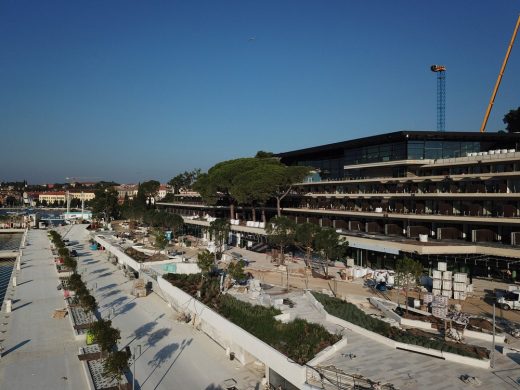
photos courtesy of architects
Grand Park Hotel Rovinj Building
Bale Sports Center Istria : Croatian Architecture by 3LHD Architects
Another recent Rovinj building by 3LHD Architects on e-architect
ResoLution Signature Restaurant Interior
Rovinj building by 3LHD Architects
Croatian Architecture – Selection
Spaladium Centar, Split
Aula Ivana Pavla II, Rijeka
Zamet Centre, Rijeka – also by 3LHD Architects
Comments / photos for the Hotel Lone Rovinj, Croatia page welcome

